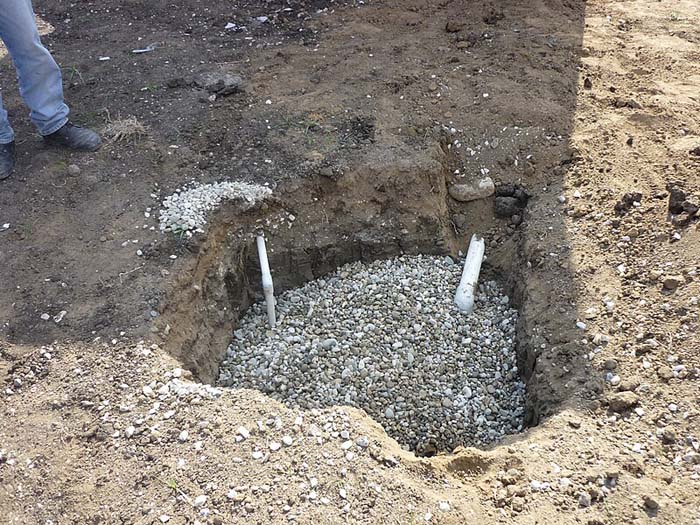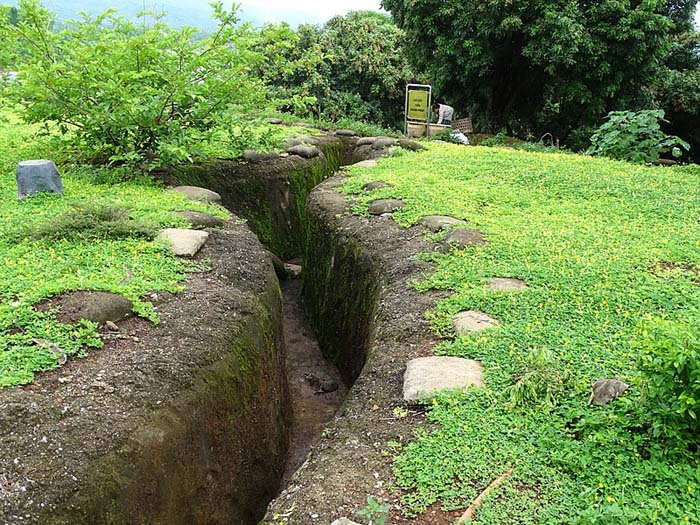
The purpose of a French drain is to redirect groundwater and surface water away from a particular location. It is sometimes referred to as a rock drain, trench drain, or weeping tile. Usually, it helps to keep water from building up around basements, foundations, or other places where too much water could create unwanted dampness or damage things. A French drain works on the idea that water travels the route of least resistance. Also, the drain makes it obvious where to go away from low-lying areas and buildings.
Components of a French Drain
- Outlet
A lower-lying area, a ditch, or a storm drain can be an appropriate outlet for the water that collects at the French drain’s end.
- Drain Pipe
At the base of the excavation is a pipe with holes cut into it. Water can enter from the top and sides through this pipe. It then directs the flow away from the troublesome location.
- Filter Fabric
Then, to keep the pipe clear of debris and dirt, it is laid along the trench and covered with gravel.
- Trench
You should dig a trench wherever you wish to install a French drain. A standard slope of one inch for every eight feet will provide adequate drainage.
– Step to follow to install a French drain
You should install a French drain to control water in a basement or yard or avoid floods. It is a drainage system that redirects water away from a certain area. In general, a French drain installation entails the following steps:
Materials Needed
- Gravel rake
- Wheelbarrow
- Geotextile or Landscape fabric
- Gravel (1-1/2 – 3/4 inches)
- PVC cement (if needed)
- Level
- Saw (for cutting pipe)
- Rubber mallet
- Trenching tool or Shovel
- Perforated drainage pipe
Plan and Prepare
- Identify the Problematic Area
Find out whether the water flows in a specific direction or pools elsewhere. A French drain is important for directing water away from low-lying regions or structures.
- Drainage System Design:
The French drain must be carefully planned out, starting at the place where water gathers and ending at the point where it’s either absorbed or exists. There has to be a downward for water to flow.
Look for Underground Utilities
Contact the relevant utility providers before beginning excavation to prevent damage to underground pipes, cables, or other utilities.
Installation
- Dig the Trench:
The first step is to lay out your route by digging a trench. The trench width should be between 6 and 12 inches, and the depth should be 12 to 18 inches. The volume of water you’re handling, and the diameter of the pipe will determine the width and depth.
- Create a Slope
To direct water away from the drain, you need a minimum slope of one inch for every eight feet in length. Use a level to verify the slope.
- Add Landscape Fabric
Before you lay pipes or gravel, line the trench with enough geotextile or landscaping fabric to fold over the edges. If dirt gets stuck in the pipe, this cloth will keep it from clogging.
Adding the Drainage Pipe
- Lay Gravel Base:
Pour gravel into the trench to a depth of a few inches. This gives the drainage pipe a solid foundation.
- Install Perforated Pipe
After spreading gravel, set the perforated drainage pipe on top. Make sure the holes point downward so water may flow into the pipe.
- Connect Pipes if Needed
Use pipe connectors or PVC cement to make sure the connections between pipes are secure. Direct the flow of water by using a non-perforated pipe or capping open ends.
- Spread Gravel Over the Pipe
Make sure to cover the pipe with gravel completely. Before you drape the landscaping fabric over the gravel, make sure you leave adequate room.

- Fold Over the Fabric
Carefully cover the gravel with the landscape cloth by folding it over it. Therefore, dirt won’t be able to clog the system as easily.
Final Touches
- Drainage Test
After installation, running water through the system to test the French drain is best. This will ensure that the water can flow through and out properly.
- Add Grass or Landscaping
After filling the trench, you can add landscaping elements or grass. This will merge the French drain more seamlessly with your yard’s landscape.
- Backfilling the Trench
Cover the fabric with soil and fill the trench up to the ground level. Compact and level the earth by tamping it down.
Safety Tips
- Use extreme caution when handling power tools and heavy materials.
- When digging, always wear safety gear such as boots and gloves.
Additional Tips
- Regulations and Permits
Prior to installation, make sure you comply with any local regulations.
- Safety Measures
When excavating, you should always contact a local utility locater service to ensure you don’t hit any hidden utilities.
- Advice from Experts
When dealing with large-scale drainage or complex installation problems, it may be wise to seek the advice of a civil engineer or drainage expert.
Benefits of installing a French drain
There are a number of advantages you can get when you install a French drain
- Increased Property Value
Effective foundation protection and water management can raise the value of your property by enhancing the landscape and decreasing the likelihood of damage.
- Water Management
French drains are a great way to prevent water from flooding and pooling in places where it tends to collect. This is especially beneficial in areas where the soil drains poorly or when rainfall is frequent.
- Preventing Basement Flooding
Basements are notorious for water seepage, which can cause floods, mold growth, dampness, and other home problems. A French drain can lessen the chances of water flooding the basement by directing water away from the structure.
- Decreased Soil Erosion
Lawns, gardening areas, and other landscape features are vulnerable to soil erosion due to excess water. French drains aid soil stabilization and erosion prevention by redirecting water away from unstable areas.
- Preserving Landscapes and Yards
French drains can help keep your yard and landscaping in good condition by avoiding soil erosion and waterlogging. This becomes paramount when dealing with uneven terrain or slopes.
- Affordable Solution
If you want to save money, French drains are a good alternative to costly repairs or drainage systems due to water damage. Compared to other drainage technologies, its installation can be easier and cheaper.
- Foundation Protection
Problems with the building’s foundation, such as shifting and cracking, might result from standing water near the foundation. Water can be directed away from your home’s foundation with the help of French drains. This lowers the likelihood of structural damage.
Disadvantages of installing a French drain
French drains are a common way to control water runoff in many agricultural, commercial, and residential landscapes. They are not without their drawbacks:
- Impact on the Environment
Poorly channeled drainage can result in environmental problems, such as the pollution of nearby water supplies or detrimental environmental impacts. Planning and considering environmental factors is essential when building a French drain.
- Disruption to Landscaping
During installation, digging and removing plants, soil, and other landscaping components may be necessary. This might disrupt the current landscape, and restoration and replanting can drive up the final price.
- Regulatory Factors to Think About
Drainage systems and water runoff are subject to rules in some areas. The project’s complexity may increase if permits or specific regulations are needed to install a French drain.
- Poor in Handling Heavy Flooding
While French drains are great for managing surface and underground water, they may need to be installed more frequently in areas with severe or regular flooding, which could require the use of additional drainage systems.
- Possibility of Clogging
Debris, roots, or dirt can cause French drains to clog over time. This can compromise their functionality, necessitating frequent maintenance or, in extreme circumstances, reinstallation.
- Risk of Wrong Installation
Improper French drain installation can worsen drainage issues, cause water to pool, and potentially damage structures. Precision in sloping, material selection and depth is essential, and experienced workers are needed.
- Limited Lifespan
French drains can only last as long as the installation and maintenance are up to par. If a system fails within a few years, it may take more effort to replace or fix it if it isn’t well-built or maintained.
- Soil Erosion
Water running down a French drain can cause soil erosion, undermine buildings, or damage the landscape if it is not controlled.
- Maintenance on a Regular Basis
Regular inspection and maintenance are essential for French drains to function properly. This process includes drainage inspections, clogging inspections, and debris removal.
- Installation Cost and Labor
A French drain installation can be pricey if it requires skilled labor, extensive digging, and expensive materials (such as perforated pipes and gravel). The costs will go up as the project gets more intricate.
When deciding whether French drains are the best option for a drainage issue or specific setting, consider their advantages and drawbacks.
Conclusion
French drains are an effective and multipurpose solution to water management problems. They keep your property dry and safe from water damage.
